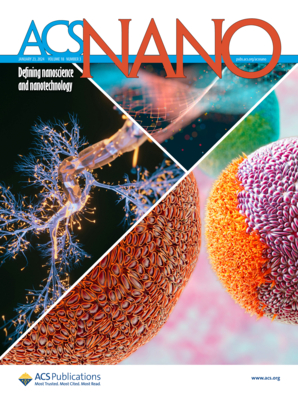Direct Modulation of Host Cells and Gut Microbiota by Orally Delivered Antioxidant Nanocages for Colitis Treatment
IF 16
1区 材料科学
Q1 CHEMISTRY, MULTIDISCIPLINARY
引用次数: 0
Abstract
Ulcerative colitis (UC) involves a complex interplay of mucosal inflammation, intestinal barrier dysfunction, and gut dysbiosis, all exacerbated by elevated reactive oxygen species (ROS). Existing therapies often fail to concurrently address these interrelated pathologies. Here we present an orally administrable nanocage system that targets both host cells and gut microbiota and can simultaneously address immune dysregulation, epithelial damage, and microbial imbalances for UC treatment when loaded with antioxidant enzymes. This system features a poly(tertiary amine oxide) (PTAO)-based zwitterionic shell and ROS-labile cross-linkers around individual protein molecules. This structure provides robust cargo protection and retention during gastrointestinal transit and enables ROS-triggered release at inflamed sites. Upon internalization by intestinal epithelial cells and macrophages, the nanocages can be directed to mitochondria for efficient ROS scavenging, which promotes epithelial repair and macrophage repolarization. Moreover, the PTAO shell provides bacterial permeability that allows direct enzyme delivery into gut microbes, thus protecting them from oxidative damage and restoring microbial balance. In mouse models of UC and acute radiation colitis, this multifunctional system effectively alleviated inflammation, restored gut homeostasis, and reduced colonic damage, demonstrating its promising therapeutic potential for colitis treatment.

口服抗氧化纳米笼治疗结肠炎对宿主细胞和肠道微生物群的直接调节
溃疡性结肠炎(UC)涉及粘膜炎症、肠屏障功能障碍和肠道生态失调的复杂相互作用,所有这些都因活性氧(ROS)升高而加剧。现有的治疗方法往往不能同时解决这些相互关联的病理。在这里,我们提出了一种口服给药的纳米笼系统,它既针对宿主细胞,也针对肠道微生物群,可以同时解决UC治疗中含有抗氧化酶的免疫失调、上皮损伤和微生物失衡问题。该体系具有聚叔胺氧化物(PTAO)为基础的两性离子外壳和ros -不稳定的交联剂围绕单个蛋白质分子。这种结构在胃肠道运输过程中提供了强大的货物保护和保留,并使炎症部位释放ros触发。在被肠上皮细胞和巨噬细胞内化后,纳米笼可以被引导到线粒体中进行有效的ROS清除,从而促进上皮修复和巨噬细胞的再极化。此外,PTAO外壳提供细菌渗透性,允许直接将酶递送到肠道微生物中,从而保护它们免受氧化损伤并恢复微生物平衡。在UC和急性放射性结肠炎小鼠模型中,该多功能系统有效减轻炎症,恢复肠道稳态,减少结肠损伤,显示出其治疗结肠炎的良好潜力。
本文章由计算机程序翻译,如有差异,请以英文原文为准。
求助全文
约1分钟内获得全文
求助全文
来源期刊

ACS Nano
工程技术-材料科学:综合
CiteScore
26.00
自引率
4.10%
发文量
1627
审稿时长
1.7 months
期刊介绍:
ACS Nano, published monthly, serves as an international forum for comprehensive articles on nanoscience and nanotechnology research at the intersections of chemistry, biology, materials science, physics, and engineering. The journal fosters communication among scientists in these communities, facilitating collaboration, new research opportunities, and advancements through discoveries. ACS Nano covers synthesis, assembly, characterization, theory, and simulation of nanostructures, nanobiotechnology, nanofabrication, methods and tools for nanoscience and nanotechnology, and self- and directed-assembly. Alongside original research articles, it offers thorough reviews, perspectives on cutting-edge research, and discussions envisioning the future of nanoscience and nanotechnology.
 求助内容:
求助内容: 应助结果提醒方式:
应助结果提醒方式:


